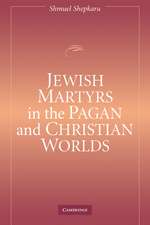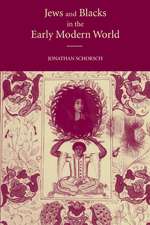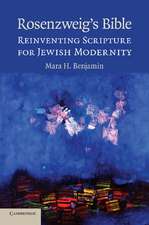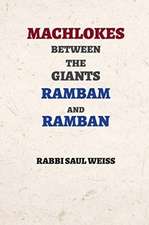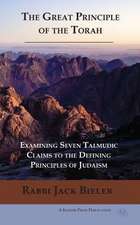Rabbis and Classical Rhetoric: Sophistic Education and Oratory in the Talmud and Midrash
Autor Richard Hidaryen Limba Engleză Paperback – 11 sep 2019
Preț: 288.42 lei
Nou
Puncte Express: 433
Preț estimativ în valută:
55.19€ • 57.77$ • 45.93£
55.19€ • 57.77$ • 45.93£
Carte tipărită la comandă
Livrare economică 31 martie-14 aprilie
Preluare comenzi: 021 569.72.76
Specificații
ISBN-13: 9781316628355
ISBN-10: 1316628353
Pagini: 347
Ilustrații: 2 b/w illus.
Dimensiuni: 151 x 229 x 12 mm
Greutate: 0.47 kg
Editura: Cambridge University Press
Colecția Cambridge University Press
Locul publicării:New York, United States
ISBN-10: 1316628353
Pagini: 347
Ilustrații: 2 b/w illus.
Dimensiuni: 151 x 229 x 12 mm
Greutate: 0.47 kg
Editura: Cambridge University Press
Colecția Cambridge University Press
Locul publicării:New York, United States
Cuprins
Introduction; 1. Rabbis as orators: the setting and structure of rabbinic homilies; 2. Rabbis as instructors: rhetorical arrangement and reasoning in the Yerushalmi; 3. The agonistic Bavli: Greco-Roman rhetoric in Sasanian Persia; 4. Progymnasmata and controversiae in rabbinic literature; 5. Talmudic topoi: rhetoric and the hermeneutical methods of Midrash; 6. The role of lawyers in Roman and rabbinic courts; 7. Why are there lawyers in heaven?; Conclusion: rabbinic versus Christian approaches to rhetoric.
Recenzii
'In this brilliant and lucid exploration of the impact of classical rhetoric on Talmudic literature, Richard Hidary shows how the ancient Jewish rabbis positioned themselves between Plato and the sophists, between philosophy and rhetoric, between truth and subjectivity. An innovative and nuanced elucidation of rabbinic epistemology and ontology, this volume opens new vistas on the study of ancient Judaism in its late antique Mediterranean context.' Christine Hayes, author of What's Divine about Divine Law: Early Perspectives
'Richard Hidary's examination of the nature and origin of the Talmud's unceasing and inimitable dialogue is a carefully wrought and balanced presentation of the case for seeking the origin of the unique character of both the Babylonian Talmud, and its counterpart in Roman Palestine, in the rhetorical structure of the building block of both talmuds: the sugya, which is essentially an essay in dialogue form, made up of a concatenation of arguments and counter-arguments, which, in the case of the Babylonian Talmud, often culminates in a culmination but not a resolution. Building on previous work on the Graeco-Roman sources of the Talmud's structure and nature, Hidary's monograph nevertheless breaks new ground and provides many fresh insights even for those - like myself - who have studied it since childhood.' Yaakov Elman, Herbert S. and Naomi Denenberg Professor of Talmudic Studies, Yeshiva University, New York
'This is a very important book that not too many scholars are capable of writing. Hidary brings wide and deep talmudic erudition together with an impressive command of classical sources to advance our understanding of rabbinic literature in the context of Graeco-Roman learning and culture.' Daniel Boyarin, University of California, Berkeley
'In his erudite and fascinating exposition of the breadth of the presence of Greco-Roman schools of rhetoric in Midrashic and Talmudic texts, Hidary made a wonderful contribution to our understanding of the relationship between the Rabbinic world and Hellenistic culture. In avoiding simplistic forms of parallelism, Hidary's meticulous philological and historical study illuminates brilliantly the deepest questions of revelation, truth and interpretation that were at stake in this momentous cultural encounter.' Moshe Halbertal, New York University
'… a piece of fine scholarship. ' Eric Ottenheijm, Journal for the Study of Judaism
'Richard Hidary's examination of the nature and origin of the Talmud's unceasing and inimitable dialogue is a carefully wrought and balanced presentation of the case for seeking the origin of the unique character of both the Babylonian Talmud, and its counterpart in Roman Palestine, in the rhetorical structure of the building block of both talmuds: the sugya, which is essentially an essay in dialogue form, made up of a concatenation of arguments and counter-arguments, which, in the case of the Babylonian Talmud, often culminates in a culmination but not a resolution. Building on previous work on the Graeco-Roman sources of the Talmud's structure and nature, Hidary's monograph nevertheless breaks new ground and provides many fresh insights even for those - like myself - who have studied it since childhood.' Yaakov Elman, Herbert S. and Naomi Denenberg Professor of Talmudic Studies, Yeshiva University, New York
'This is a very important book that not too many scholars are capable of writing. Hidary brings wide and deep talmudic erudition together with an impressive command of classical sources to advance our understanding of rabbinic literature in the context of Graeco-Roman learning and culture.' Daniel Boyarin, University of California, Berkeley
'In his erudite and fascinating exposition of the breadth of the presence of Greco-Roman schools of rhetoric in Midrashic and Talmudic texts, Hidary made a wonderful contribution to our understanding of the relationship between the Rabbinic world and Hellenistic culture. In avoiding simplistic forms of parallelism, Hidary's meticulous philological and historical study illuminates brilliantly the deepest questions of revelation, truth and interpretation that were at stake in this momentous cultural encounter.' Moshe Halbertal, New York University
'… a piece of fine scholarship. ' Eric Ottenheijm, Journal for the Study of Judaism
Notă biografică
Descriere
Shows the unique perspective of Talmudic rabbis as they navigate between platonic objective truth and the realm of rhetorical argumentation.

